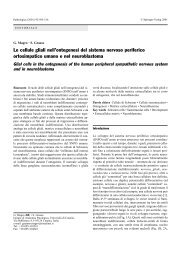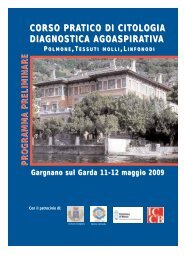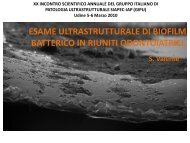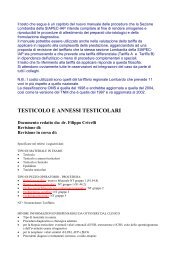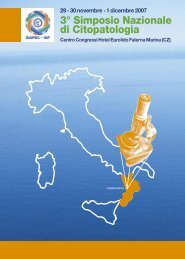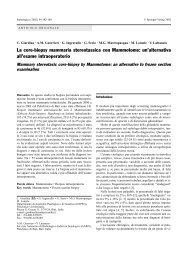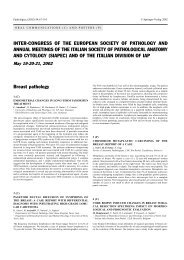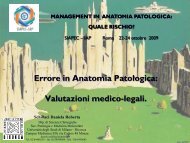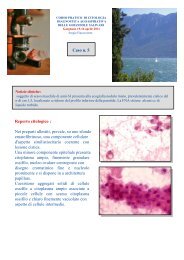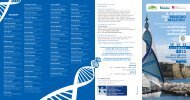392COMUNICAZIONI LIBEREAromatase expression in human testicularseminomaF. Romeo * , V. Rago ** , G. Capocasale * , S. Andò *** , A. Carpino***Pathologic Anatomy Unit, Annunziata Hospital, Cosenza; **Cell Biology and Pharmaco-Biology Departments; *** Facultyof Pharmacy, University of CalabriaIntroductionCytocrome P450arom is a terminal enzyme catalysing theconversion of androgens into estrogens. Its expression hasbeen reported in different human tissues, including testes. Inaddition, aromatase has been investigated in human neoplastictissues for the estrogen ability to regulate the cell growth.In fact, P450arom overexpression has been detected in somebreast, endometrial and ovarian malignancies. Conversely,the enzyme expression in testicular tumors is scarcelyknown. This study has been addressed to immunolocalizearomatase in human testicular seminoma.Materials and methodsThe tumour-bearing testes were obtained, after informed consent,from 7 patients (aged from 30 to 50) with classic seminoma,undergoing to therapeutic orchidectomy. Paraffin-embeddedtestes were processed for immunohistochemistry usinga rabbit polyclonal antibody generated against humanplacental cytochrome P450arom. Then, biotinylated goatanti-rabbitIgG was applied followed by avidin-biotin-peroxidasecomplex. The peroxidase reaction was developed withdiaminobenzidine. Furthermore, hematoxylin-eosin stainingwas used for morphological analysis.ResultsP450arom immunoreactivity in the cells was detected as cytoplasmicstaining. All the samples showed similar immunostainingpatterns: i) In tumoral region, the cords of neoplasticcells showed a strong immunoreactivity, while thesurrounding abundant lymphocytes and connective cellswere immunonegative ii) In the region near the tumor margin,Leydig cells were strongly immunoreactive and an intensestaining was also observed in the big neoplastic cells ofthe modified tubules, identified as intratubular seminoma iii)In the region far from the tumor, Leydig cells were immunopositiveand no staining was observed in the tubuleswith seminiferous epithelium showing all the spermatogeneticstages. Conversely, those tubules with spermatogenetic arrest,showed a clear immunostaining in the basal cells.ConclusionsThe present study has demonstrated, for the first time, aromataseexpression in neoplastic cells of human seminoma. Infact, still now, aromatase presence in human testis tumors hasbeen reported only in stromal cells of non-seminoma tumorsand in sex cord tumor of young patients with the Peutz-Jeghers syndrome. Furthermore, testicular parenchyma, adjacentto the tumor, showed a differential aromatase expressionaccording to the tubular dysmorphy. This suggests a possiblerelationship between tumor progression and intratubular localizationof the enzyme. In fact, estrogens deriving from the“in situ” aromatization could act as autocrin mytogen factorspromoting neoplastic process.Bibliografia1Cairns P et al. Cancer Res 1994;54:1422-1424.2Gonzalgo ML et al. Cancer Res 1998;58:1245-1252.
PATHOLOGICA 2004;96:393-397MiscellaneaConfronto tra diagnosi clinica e riscontrodiagnostico nell’identificazione delle cause dimorteV. Arena * , B. Federico **, V.G. Vellone * , F. De Giorgio *** ,G. Capelli ** , A. Capelli **Istituto di Anatomia Patologica, Università Cattolica delSacro Cuore, Roma; ** Cattedra di Igiene, Università di Cassino;*** Istituto di Medicina Legale, Università Cattolica delSacro Cuore, RomaIntroduzioneL’accuratezza della certificazione di morte, base informativaper l’elaborazione delle statistiche di mortalità e per l’attribuzionedei DRG, è talora problematica in quanto la frequenzadelle patologie cardio-respiratorie è sovrastimata,mentre altre condizioni morbose sono spesso misconosciute.Il riscontro diagnostico (RD) rappresenta il “gold standard”attraverso cui giudicare la validità della presunzione clinicadel decesso. Il presente studio si è posto l’obiettivo di misurarela sensibilità delle fasi di identificazione della causa deldecesso, la presunzione clinica (PC) e l’esame autoptico macroscopico(EM), considerando quale gold standard l’esameistologico (EI).MetodiIl campione è costituito da 66 RD eseguiti nell’Istituto diAnatomia Patologia della Facoltà di Medicina e Chirurgia delPoliclinico A. Gemelli (Roma) nel periodo gennaio-giugno2004. Per ogni soggetto, sono state determinate la causa iniziale,quella intermedia e quella terminale del decesso, insiemead altri stati morbosi rilevanti sulla base della sola PC,dell’EM, e dell’EI. La sensibilità della diagnosi è stata ottenutacalcolando la proporzione delle cause iniziali di morteche concordavano con la diagnosi della causa iniziale riportatadopo l’EI. Per la classificazione delle cause di morte èstata utilizzata la 10 a revisione della Classificazione Internazionaledelle malattie e dei problemi collegati alla salute(ICD-10), verificando la concordanza sia del settore nosologicoche del codice.RisultatiLa sensibilità della diagnosi di causa iniziale di morte è statapari al 15% per la PC e pari al 67% per l’EM. Considerandoil settore nosologico, tali valori sono risultati 59% e 85% rispettivamente.L’EM mostra una sensibilità superiore a quelladella PC, particolarmente per riscontri di neonati e bambini(15% vs. 85%) e per le morti cardiache (0% vs. 80%). Lasensibilità dell’EM è risultata inferiore per le morti da altrepatologie (neoplastiche, infettive ed ematologiche) rispettoalle morti cardiache.ConclusioniIn contrasto con il declino del RD negli ultimi decenni questirisultati rafforzano la sua validità nella determinazionedella causa di morte. Se per le morti cardiache ed in età pediatrical’EM modifica sensibilmente i dati della PC, l’EI restacomunque imprescindibile per l’affinamento diagnostico,particolarmente nei decessi per neoplasie, malattie infettiveed ematologiche.Descrizione di un caso di morte improvvisada vasculite coronaricaV. Arena * , A. Angelone ** , E. Stigliano * , F. De Giorgio *** ,J. Pizzicannella ** , A. Capelli **Istituto di Anatomia Patologica, Università Cattolica delSacro Cuore, Roma; ** U.O. di Anatomia Patologica, OspedaleCivile dello Spirito Santo, Pescara; *** Istituto di MedicinaLegale, Università Cattolica del Sacro Cuore, RomaIntroduzionePer morte improvvisa (MI) si intende un decesso per causenaturali che si verifica entro breve tempo dalla comparsa deisintomi, in un soggetto apparentemente sano o il cui stato dimalattia non faceva presagire un esito così repentino. L’eventopuò manifestarsi in soggetti in apparente stato di benessere,senza storia clinica di patologie a rischio oppure, edè la stragrande maggioranza dei casi, in pazienti affetti da patologiea rischio, ma al momento ben compensati. La MI conseguead un arresto cardio-circolatorio che può essere secondarioa causa cerebrale o respiratoria oppure dipendere primariamentedall’apparato cardio-circolatorio.MaterialiSi tratta di un uomo di 31 anni giunto cadavere in pronto soccorso.Dall’anamnesi raccolta si apprende che negli ultimigiorni prima del decesso, a seguito di un intervento di implantologiadentaria aveva avuto una febbricola. All’esamedel cuore si apprezzava una cardiodilatazione totale in organocomplessivamente aumentato di volume e di peso (gr410). Il miocardio al taglio mostrava un colorito pallido. Lecoronarie apparivano macroscopicamente indenni, si evidenziavasolo una particolare salienza rispetto al grasso subepicardico.Non veniva segnalato nulla di rilevante a carico deglialtri organi.RisultatiLo studio istologico ha documentato elementi patologici soloa livello del tessuto miocardico dove si è potuto apprezzareun ricco infiltrato linfomonocitario disposto attorno e nellospessore delle coronarie nel loro decorso subepicardico edintramiocardico. I miocardiociti presentavano fenomeni di rigonfiamentoidropico, scomparsa delle striature e focalmenteaspetti ondulati prospettando l’ipotesi di sofferenze ischemicheplurifocali.ConclusioniL’età del paziente, l’assenza di manifestazioni aterosclerotichea livello delle coronarie e degli altri organi, l’assenza difattori di rischio per aterosclerosi, quali diabete, ipertensione,ecc. e la presenza di infiltrazione infiammatoria a carattereprevalentemente linfomonocitario a livello delle coronariesia a livello subepicardico che intramiocardico, associato aisegni di sofferenza ischemica plurifocale ma corrispondentealle aree con patologia vascolare, indica la coronarite qualecausa di morte del paziente. Il coinvolgimento coronarico incorso di vasculiti sistemiche è ben descritto sia in corso dipoliarterite nodosa che in altre forme come l’arterite diTakayasu. Più rare sono invece le segnalazioni di casi isolatinon inseriti in una patologia sistemica come nel nostro caso.





